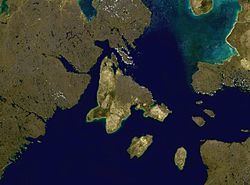Area rank 34th Highest point Mathiasen Mountain Area 41,214 km² | Highest elevation 625 m (2,051 ft) Elevation 625 m | |
 | ||
Island group Canadian Arctic Archipelago | ||
The national southampton island siig camp summer 2007
Southampton Island (Inuktitut: Shugliaq) is a large island at the entrance to Hudson Bay at Foxe Basin. One of the larger members of the Canadian Arctic Archipelago, Southampton Island is part of the Kivalliq Region in Nunavut, Canada. The area of the island is stated as 41,214 square kilometres (15,913 square miles) by Statistics Canada. It is the 34th largest island in the world and Canada's ninth largest island. The only settlement on Southampton Island is Coral Harbour (pop. 834, Canada 2011 Census), called in Inuit Salliq.
Contents
- The national southampton island siig camp summer 2007
- Map of Southampton Island Nunavut Canada
- History
- Geology
- Geography
- Fauna
- References
Map of Southampton Island, Nunavut, Canada
Southampton Island is one of the few Canadian areas, and the only area in Nunavut, that does not use daylight saving time.
History
Historically speaking, Southampton Island is famous for its now-extinct inhabitants, the Sadlermiut (modern Inuktitut Sallirmiut "Inhabitants of Salliq"), who were the last vestige of the Tuniit. The Tuniit, a pre-Inuit culture, officially went ethnically and culturally extinct in 1902-03 when infectious disease killed all of the Sallirmiut in a matter of weeks.
The island's first recorded visit by Europeans was in 1613 by Welsh explorer Thomas Button.
At the beginning of the 20th century, the island was repopulated by Aivilingmiut from Repulse Bay and Chesterfield Inlet, influenced to do so by whaler Capt. George Comer and others. Baffin Islanders arrived 25 years later. John Ell, who as a young child travelled with his mother Shoofly on Comer's schooners, eventually became the most famous of Southampton Island's re-settled population.
The Native Point archaeological site at the mouth of Native Bay is the largest Sadlermiut site on the island.
Geology
Southampton Island does have geological resources that are of scientific and industrial interest.
However, full knowledge of the island is still lacking according to the Nunavut government.
The current level of basic geoscience available for the Southampton region is inadequate to meet current exploration demands. Regional scale mapping of the bedrock geology of Southampton Island has not occurred since 1969.Only the most general of rock distinctions are made on the existing geological map, and only a very rudimentary understanding of the surficial geology exists. Currently there is no publicly available, regional-scale surficial (till) geochemical data which is essential for understanding exploration potential for metals and diamonds.Geography
It is separated from the Melville Peninsula by Frozen Strait. Other waterways surrounding the island include Roes Welcome Sound to the west, Bay of Gods Mercy in the southwest, Fisher Strait in the south, Evans Strait in the southeast, and Foxe Channel in the east.
Hansine Lake is located in the far north. Bell Peninsula is located in the southeastern part of the island. Mathiasen Mountain, a member of the Porsild Mountains, is the island's highest peak. The island's shape is vaguely similar to that of Newfoundland.
Fauna
East Bay Migratory Bird Sanctuary and Harry Gibbons Migratory Bird Sanctuary are located on the island and are important breeding sites for the lesser snow goose (Anser caerulescens caerulescens). The island is also the site of two Important Bird Areas (IBAs), the Boas River wetlands in the southwest and East Bay/Native Bay in the southeast. Both host large summer colonies of the lesser snow goose, together comprising over 10% of the world's snow goose population, with Boas River site alone hosting over 500.000 individuals nesting there. Smaller, but also important, are the colonies of the brent goose (Branta bernicla) and numerous other polar bird species there.
